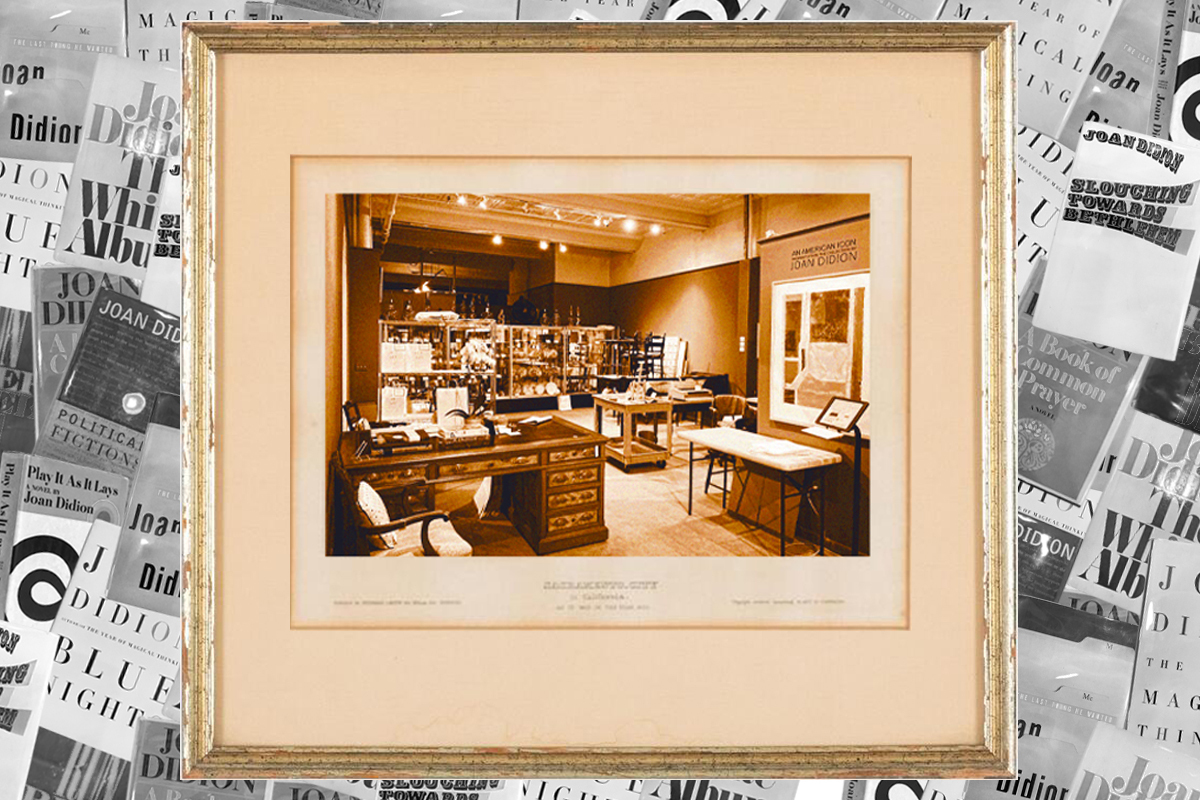I’m sure Joan Didion would have attended her own estate sale if given the chance.
The writer was the definitive chronicler of turmoil and decay in 20th century America. Later in her career, she became mired in grief, reflecting on death of her husband and daughter. Through it all, in her reporting, fiction and screenwriting, she has built a career on her powers of observation.
So when I tell people about my intentions to write about her selling the estate, I tell them that I think that’s what she would do. An estate sale, at least to me, is one of the few events that seems more final than death. There is a death, a funeral, a memorial service – the last is the sale of the estate.
Didion died in December 2021 in his Upper East Side apartment due to complications from Parkinson’s disease. A private funeral took place in April of this year, and Fr public funeral service took place in September. With the flashbacks complete, Joan Didion’s identity is now reduced to her bare aesthetic and projected onto her artifacts.
“Many lessons have been learned in death as in life,” Didion wrote of author James Jones in an essay in the 1979 White Album. Not being a part of her life, I feel compelled to learn some lessons from her death.
The auction was held on November 16 by Stair Galleries in Hudson, New York. Proceeds will benefit Parkinson’s research at Columbia University and the Sacramento College Scholarship for Women in Literature.
When I arrived in Hudson at 9:30am on Wednesday morning, I already knew I wasn’t going to get what I was hoping for. A few days earlier I found out, but not before buying the train tickets, that the sale would be conducted entirely on an online auction platform Bid Square. No one was allowed inside.
• • •
I still show up at Stair Galleries. I stand on the sidewalk for a while. Crossing the street. I sit on the steps of the Hudson Whaler Hotel and watch as a woman walks up to the front door of the gallery, finds it closed, looks around a bit, and turns to go back the way she came.
I watch through the second-story windows as people move things around until Joe Olsen, the gallery’s creative director, comes outside in a long white coat around 10:40. I take this opportunity to introduce myself. She asks me if I am a journalist. The cold works in my favor and I am invited inside.
In the lobby, Olsen introduces me to Lisa Thomas, the gallery’s director of fine art. They politely decline my attempts to observe the auction from inside the gallery, but offer me a brief tour of the room where the items are displayed. I take as much as I can: her desk, her dishes, her kitchen table where her husband died. Auras come out.
About 10 minutes before one of Stair Galleries’ biggest auctions, Olsen and I walk down the block for coffee. She introduces me to the barista as her good friend. They talk, comparing the upcoming auction with “Mad Max” – it will be a “dome”, they agree.
Didion’s recent surge in popularity among Gen Z – mainly managed by TikTok,” Olsen tells me, “enhanced the author’s already iconic status as an idol for young people who aspire to sophistication. She points to “young, smart millennial women” who started book clubs during the pandemic as a key part of the trend.
However, those who knew her know that she would not be a fan of her fans. “It has always seemed to me that to turn Joan Didion into an emblem is to distort a woman who is so not prone to reflexive condescension or sentimentality,” said writer Gia Tolentino on memorial service.
Of course, this is kind of the opposite of the point of selling celebrity real estate. Many of the items in the block went for ten times their estimate because they are Joan Didion. She made you to feel that you knew her.
“People feel like they can be close to an icon by owning something that person lived with.” – Thomas said the New York Times the last month.
• • •
Olsen returns to the gallery; I’m watching live from my coffee table. The auction begins with Lot 1, a collection of 21 copies of Didion’s own books from her personal library. It is estimated to sell for $1,000-$5,000. I watch the rates go higher and higher. The winning bid is $15,000.
Lot 5 is hers iconic sunglasses – I can feel how much money is thrown here. They are estimated from 400 to 800 dollars. Having just seen $163,000 spent in half an hour and also knowing that similar shades cost $2,500 in 2014 as part of a fundraiser for a documentary about her nephew, I expect the estimate to be an order of magnitude lower.
The sunglasses are over-the-counter, the auctioneer advertises, so “you can wear them just about anywhere.” I’m trying to imagine someone who buys Joan Didion’s Celine sunglasses to wear “pretty much everywhere.”
I actually do a lot of imagining (magical thinking if you will). The only thing I know about any of these bidders, each represented by a four-digit number, is that they can spend thousands and thousands of dollars.
Left to my imagination, I imagine that each of them is a dispassionate collector with incredible wealth at his disposal, interested only in prestige, exclusivity and status. It’s easy to imagine because it’s hard to imagine anything else in an online forum—it lacks any human passion.
“You’ll be very sorry if you don’t bid,” the auctioneer reminds the unseen audience as I watch bidders 3441 and 4319 battle it out for the sunglasses.
At $20,000, bidder 4319 drops out after a few thousand dollars from 3441. Bidder 4514 takes their place and gets $22,000. But 3441 wants more. After 3441 counters $26,000 with 4514 with a final bid of $27,000, 4514 retreats.
I’m trying to imagine someone who wants Didion sunglasses badly enough to spend $20,000, but not badly enough to spend $22,000. Someone else who has $26,000 but draws the line to $28,000.
At some point, the excitement turns to dark delight. I couldn’t stop imagining what it would be like to own an object owned by Didion, couldn’t stop resenting the people who would get their hands on it, but after a few hours of haggling, weariness sets in.
I go to the city library. I’m cold, tired, hungry; I forgot what money meant. Just $3,500 for a set of plates? A low sum, I thought. It didn’t matter that my own set cost a hundredth of that amount at IKEA – I was immersed in another world.
At US$110,000 a painted portrait of Didion — Lot 4, valued at $3,000-$5,000, ended up being the most expensive sale. A group of art catalogs and a Victorian side chair — lots 104 and 126, estimated at $100-150 and $300-500 respectively, are the cheapest, each costing only $1,100. The press release puts the total revenue at $1.9 million.
• • •
Many young writers consider themselves intellectual heirs of Didion. No matter how pretentious it sounds, I think I would be lying if I said that I myself do not strive for this. I also think that if you’re the type of person who’s read this far, you’d also be lying to yourself if you said you didn’t feel the same way.
Of course, not all of us will become the next Didion. No one is actually going to be the next Didion, but the point is that many of us will try. David Remnick, editor of the New Yorker, noted at the memorial ceremony that she is particularly admired by young writers.
“I wish them all the best of luck,” Remnick said, addressing her many imitators. “She is unique.”
But I don’t think that’s quite right. It is easy to imitate, at least as I see it, precisely because of what makes it impossible to replicate. Didion’s aesthetic, both literary and personal, is so distinctive that it’s tempting to adorn yourself in her style with designer glasses or obscure adjectives. You can try the declension paradigm as if it were a couple large tortoiseshell glasses; you can assume a self-conscious neuroticism as you pick up smoking.
That’s what appealed to me about the estate sale, even though I couldn’t participate in it myself. The thought of being able to retain a bit of Joan Didion’s personality (at least what one imagines her to be) is intoxicating.
With her belongings now confiscated, her literary legacy is up for grabs. It will take some time to separate the heirs from the imitators. Until then, we are grandchildren shortly after the death of the family matriarch, waiting to see who she thought she would include in her will, waiting to see who would get the vintage silver candlesticks and who would be forgotten.
Of course, none of us received real candlesticks; they went to Bidsquare user 3204 — lot 224 sold for $8,000.
Contact Alex Tay at [email protected]







